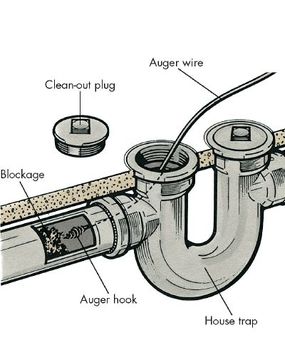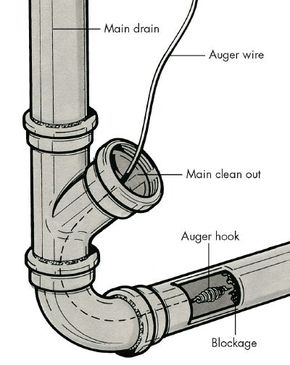How To Clear Floor Drains and Main Drainpipe Blockages
For clogged floor drains, such as those in basements and showers, a garden hose can be effective in unclogging drains, especially if the clog is not close to the opening. Attach the hose to a faucet, feed the hose into the drain as far as it will go, and jam rags around the hose at the opening. Then turn the water on full force for a few moments.
If you suspect a clog is in the main drainpipe, locate the main clean out. This is a Y-shape fitting near the bottom of your home's soil stack or where the drain leaves the building. Set a large pail or container under the clean out, and spread plenty of papers and rags around the site to soak up the backed-up water.
Advertisement
Using a pipe wrench, slowly unscrew the clean-out plug counterclockwise, trying to control the flow of water that will seep from the clean out. Once the flow has stopped and you've cleaned up the flooded site, insert the auger to remove the debris.
If you still haven't located the blockage, another place you can try is the house trap. This is a U-shape fitting installed underground. You can locate it by finding two adjacent clean-out plugs in the floor, if the main drain runs under the floor. Again, place papers and rags around the site before opening the clean out nearest to the sewer outside.
If the clog is in the house trap or between the trap and the main clean out, you should be able to remove it. But if the water starts to flow out of the trap as you unscrew it, check quickly beyond the house trap with an auger. If you can remove the clog rapidly, do so. Otherwise, replace the trap plug and call in a professional to do the job.

There is one type of drain clog that will not respond satisfactorily to a plunger or an auger. This is when the main drain outside the building or a floor drain in the basement gets stopped up from tree roots that have grown in at the joints. The most effective solution in this case is a power auger or an electric rooter, which is inserted into the pipe and cuts away roots from the pipe walls as it moves along. You can rent a power auger at a home improvement or tool rental store. Feed the auger cable into the cleanout opening closest to the blockage. When the device's cutting head encounters roots, you should be able to feel the cable strain. Keep feeding the cable slowly until you feel a breakthrough, then go over the area once again.
Remove the cable slowly, and run water from a garden hose through the pipe to wash away the root cuttings. Before you return the power auger to the rental firm, replace the clean-out plug, and flush a toilet several times. When you're sure the drain is clear of tree roots, clean the cable.
The drain trap is an integral part of your home's drainage system. We'll show you how to replace a drain trap in the following section.
